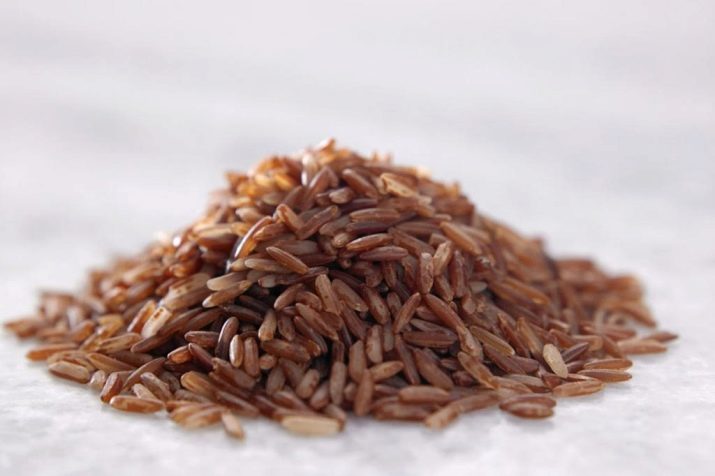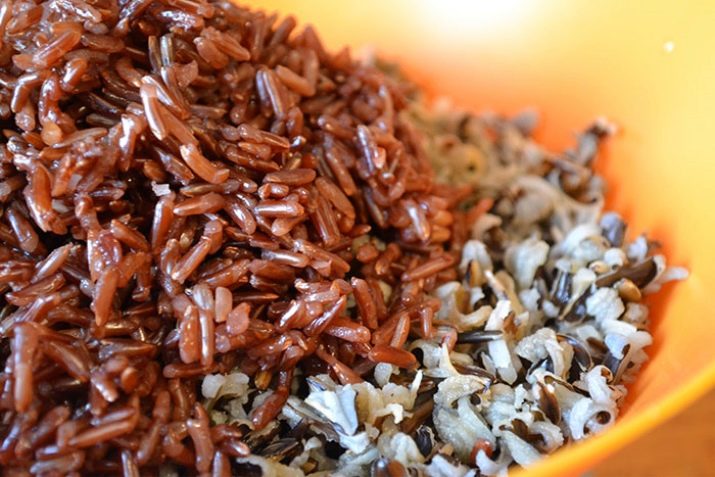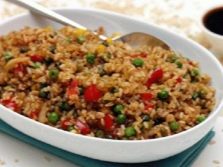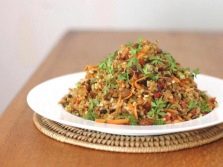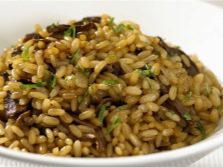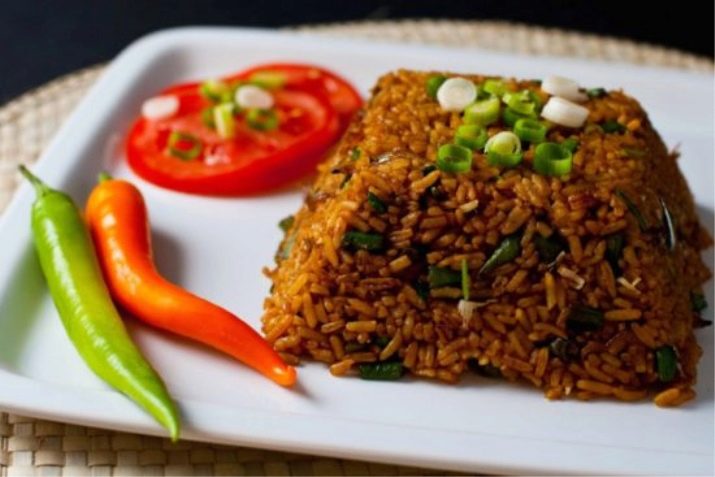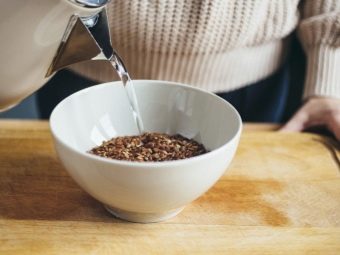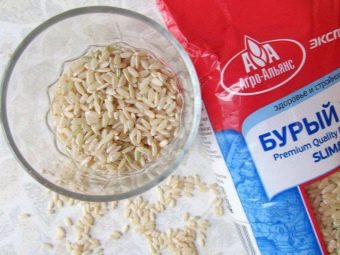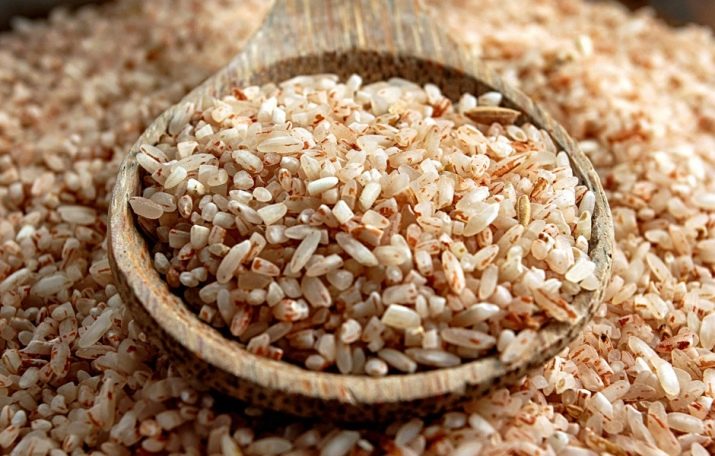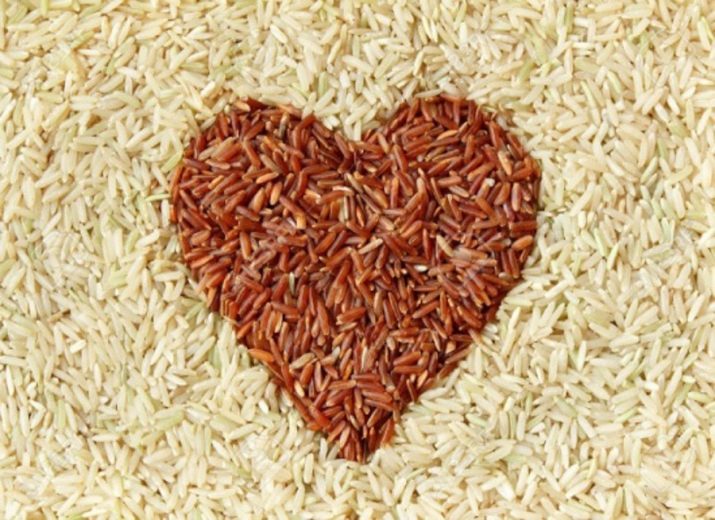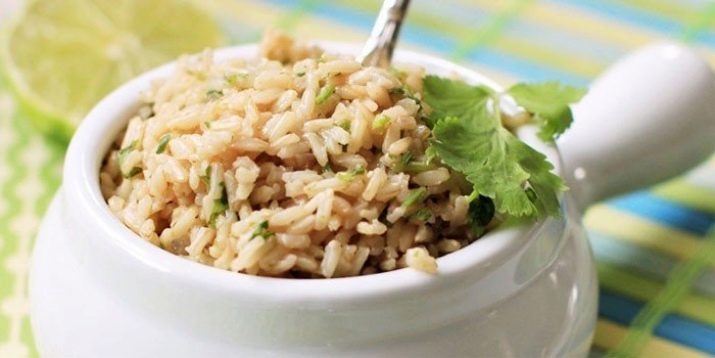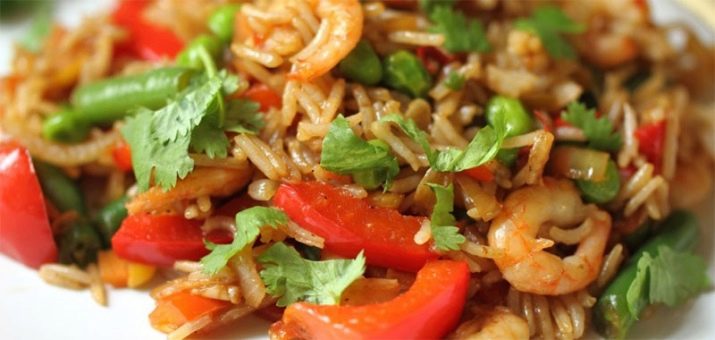Calorie and composition of brown rice
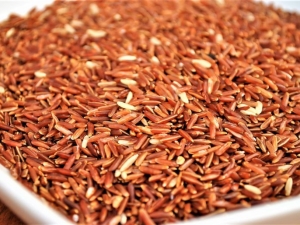
Brown rice is an ancient cereal culture.This cereal is very popular in eastern countries, where it is consumed every day, due to its excellent balanced composition, due to which brown variety is considered one of the best low-calorie cereals. It is worth more to consider the benefits, composition and caloric content of this wonderful product.
Benefits and contraindications
In essence, brown and white rice cereals are one and the same product, but processed by different methods. The brown variety undergoes a smaller number of treatments, and only the purification of the grains from the yellowish upper peel takes place in production. But the bran shell is left intact, which is why the grains of this variety have a brown tint and an elongated shape. Brown variety has an interesting nutty flavor and aroma. In our country, brown rice cereals are not as strong as white rice.
However, in Asian countries, this product is famous for its many beneficial properties and is one of the main dishes of the daily diet of each family.
The brown variety has the following beneficial properties:
- regular use of this type of cereal can significantly reduce the level of cholesterol in the blood;
- promotes proper functioning of the gastrointestinal tract;
- if necessary, clean the walls of the stomach and intestines, as well as rid the body of toxic substances, it is recommended to use a small portion of brown rice daily; as well as this product helps to get rid of constipation and strong flatulence;
- often a brown variety is introduced into the diet of patients with a disease such as gastritis or gastric ulcer;
- is one of the main components of the rice diet or rice discharge day;
- cooks often use rice as a side dish for all sorts of meat and fish, and rice is an excellent basis for cooking porridge, pudding, salad or traditional pilaf;
- due to its unique ability to absorb moisture, brown cereal is used to restore the hydrobalance in the human body;
- medical research has shown that regular use of brown rice improves blood circulation;
- brown grass may have a relaxing effect on nerve cells and the brain, and therefore it is advisable to include this variety of rice in a daily diet for a person who is subject to constant mental stress or is prone to experience nervous exhaustion;
- It helps to strengthen the teeth and gums, and also improves the appearance of the skin and hair;
- due to the significant content in the composition of this variety of vitamin A there is a chance of improving vision with constant use of the product;
- helps to restore normal sleep patterns, helps fight insomnia and irritable condition;
- helps to improve the work of the digestive organs, helps to remove slag formations and metabolic products from the body.
Like any product, this variety of cereals tend to have a number of contraindications. First of all, this product is contraindicated for a person suffering from severe abdominal distention. In this case, it is desirable to give preference to white varieties of cereal, using them no more than twice in seven days. It is strongly not recommended to use brown rice cereals when urinating difficulties. Uncooked croup has a rather potent diuretic effect. If a person has colitis, it is also worth refusing this product. With a relatively low calorie content of one hundred grams of brown cereal, they should not be abused if there is a large body mass.
Due to the fact that rice groats tend to be digested for a long time, there is a chance of gaining extra pounds.
Composition
Do not forget that any cereal is a carbohydrate.However, brown rice groats belong to the “long-lasting” and useful form of carbohydrates, which are completely split in the human body. They are perfectly recycled, giving a person an energy charge, and not deposited in the form of fat deposits. In turn, this rice variety is also rich in vegetable protein, which is a building material for muscle fibers.
It is worthwhile to dwell on the equally important components of the composition of the brown variety.
- Dietary fiber, often referred to simply as fiber. The content of dietary fiber in brown rice cereal is a little, only three grams per two hundred grams of cereal. However, in comparison with white varieties of rice, which contain only one gram of fiber in two hundred grams of cereals, it is better to give preference to eating brown rice. When boiling brown rice in water, the calories in the dish will be relatively few, due to the presence of coarse dietary fiber in the composition.
- The full complex of B vitamins made brown rice grade incredibly popular in eastern countries. One portion of this product can almost completely close the daily need of the human body in these elements. However, rice groats, past heat treatment, reduces the content of these useful vitamins five times. In other words, in boiled rice, their concentration is much lower than in raw.
- The content of metals necessary for the body also brings this product to a leading position in the number of useful elements in the composition. Brown rice cereal is a rich source of copper, zinc, manganese, magnesium and iron. In the composition can be detected and a small amount of sodium, a rather rare metal found in food. This is the chemical composition of the product.
- The presence of phosphorus, selenium and iodine in brown rice allows using this product as a prophylactic agent for thyroid disease.
By eating 50–70 grams of cooked brown rice, you can cover the daily need of the body for these elements.
Calorie, BJU and glycemic index
Low calorie brown rice makes this product a favorite of all who are actively fighting with those extra pounds. The calorie content in one hundred grams of brown rice cereal is approximately three hundred and thirty calories. And in this case we are talking about a dry product. But one hundred grams of boiled brown rice already contains one hundred and ten kilocalories. Such a strong decrease in the energy value of rice cereal is due to the pretreatment to which the cereal is subjected before cooking. It is no secret that it is advisable to wash rice cereal regardless of the variety in cool water several times, which helps to remove starch and adhesive, which is also called gluten.
It is these two elements that add to the cereal energy value in the form of kilocalories.
We should also mention the nutritional value of this variety. This information will be useful to all, especially those who are interested in the use of extremely low-calorie foods. The main part of brown rice cereals, as mentioned earlier, is occupied by complex carbohydrates, about seventy-four percent. The protein content per 100 grams is quite significant when compared with the rest of cereals, about twenty-four percent. The fats in the composition of brown rice occupy the smallest part - only two percent. By the way, even a small percentage of fat in the composition of the brown variety is presented in the form of useful oils that have a beneficial effect on the human body.
First you need to recall what is the glycemic index. Deeply delving into medical terminology, the glycemic index or GI is an indicator indicating the difference in the level of sugar in the blood vessels after any food.Sugar, starch and glucose have a value of 100 units. And raw cabbage will be marked in about ten units. It is worth comparing the two main varieties of rice cereal - white and brown. The glycemic index of white rice is eighty-five units. While the glycemic index of brown rice grains varies from forty-five to fifty units. Consequently, the use of brown rice contributes to the increase of sugar in the blood vessels in two times less, compared to white varieties. In this regard, white rice grains are usually attributed to an unhealthy, fast group of carbohydrates, and brown rice, by contrast, is a slow and useful group of carbohydrates.
Counting calories in different dishes
The calorie content of one hundred grams of boiled brown variety can vary considerably from one hundred grams of raw product. This is due to the active absorption of water by the grains during the boiling process, which contributes to an increase in mass. And it is also necessary to consider the added ingredients, such as salt, a spoonful of butter, a handful of raisins and fat content of milk. Salt is the only ingredient of the above, which does not contribute to an increase in caloric content of the finished dish. While a hundred grams of butter can increase the energy value of cooked brown rice by seven hundred and forty-eight calories.
People tend to ignore the fact that the added ingredients add a few calories to the dish. Do not forget about it, because it can lead to a set of extra pounds. Raisins, which are often added when cooking pilaf, will increase the calorie content of the dish by two hundred and sixty-four calories (per hundred grams). One teaspoon of sugar contains sixteen calories. As for milk, there is no definite answer. Its caloric content will depend on the fat content in its composition. For example, the calorie content of brown rice in milk, whose fat content is two and a half percent, while not adding any additional ingredients, will be approximately one hundred and ten calories per hundred grams of the finished dish.
A brown variety cooked with a steamer has a higher energy value when compared with boiled one hundred fifty five calories per hundred grams of food. Boiled brown rice becomes more useful when adding stewed vegetables such as sweet peppers, carrots, green peas and corn. Boiled vegetables do not greatly change the calorie content of the dish, and, as a rule, boiled rice with vegetables contains no more than one hundred and eighteen calories. Adding seafood to boiled brown rice is another great way to diversify your diet without harming your body.
For example, a dish of rice and mussels will be only 121 kcal.
About the benefits of brown rice, see the following video.

